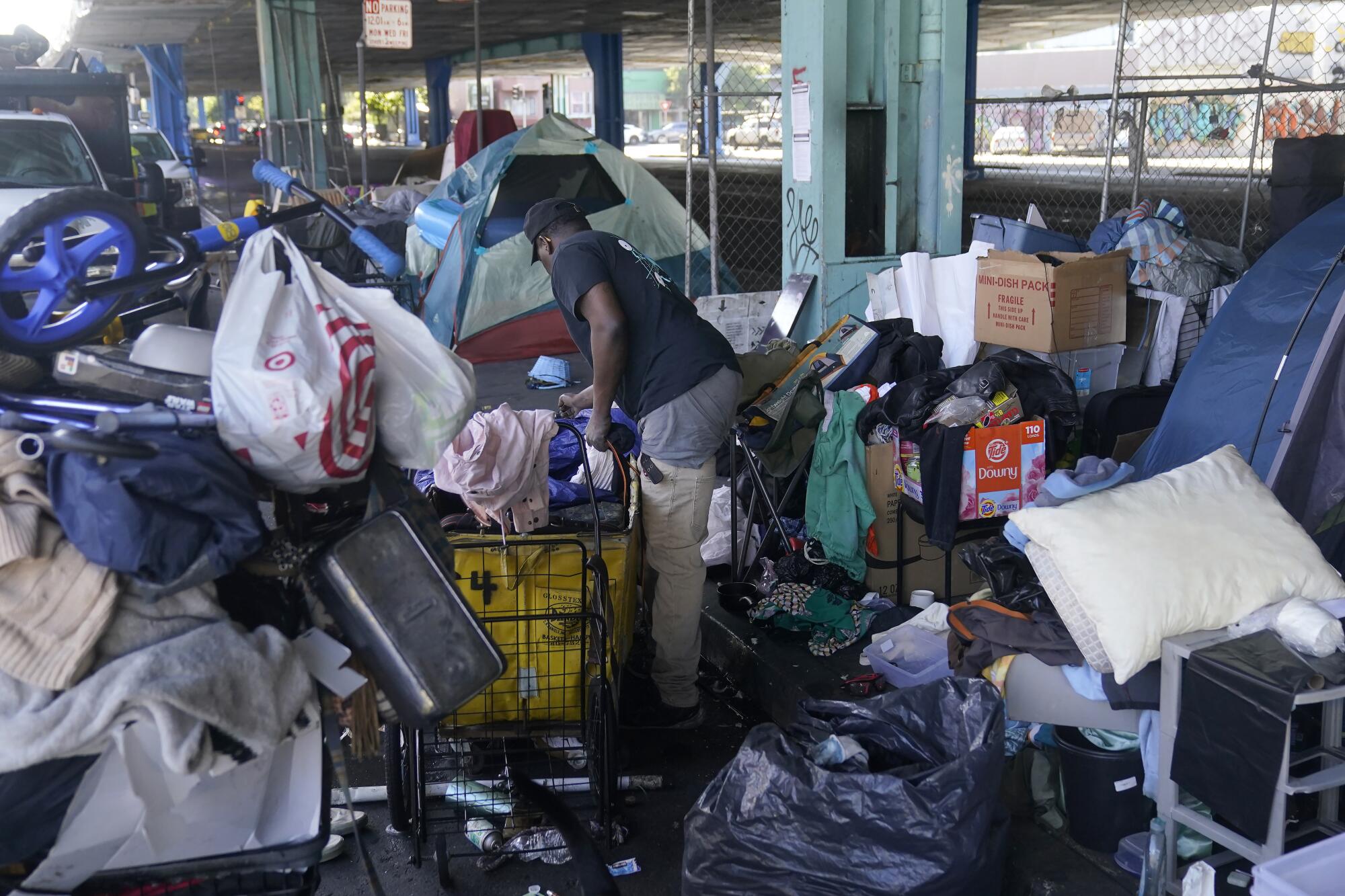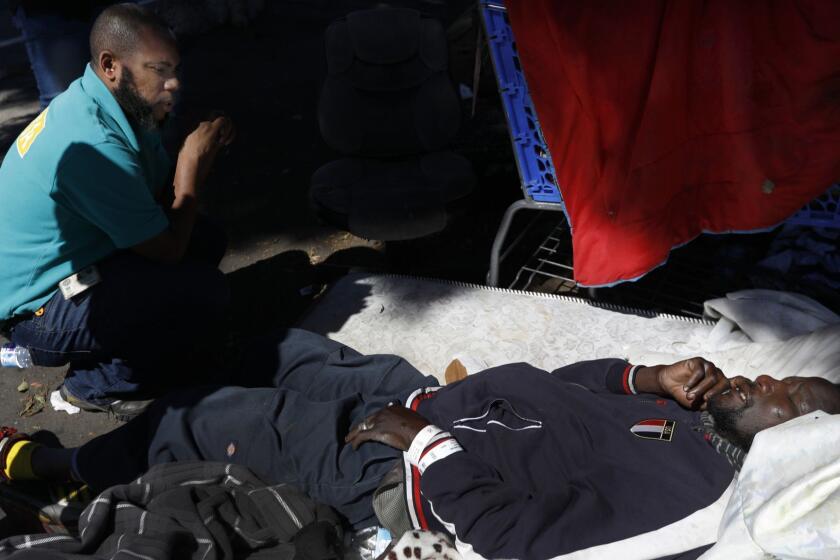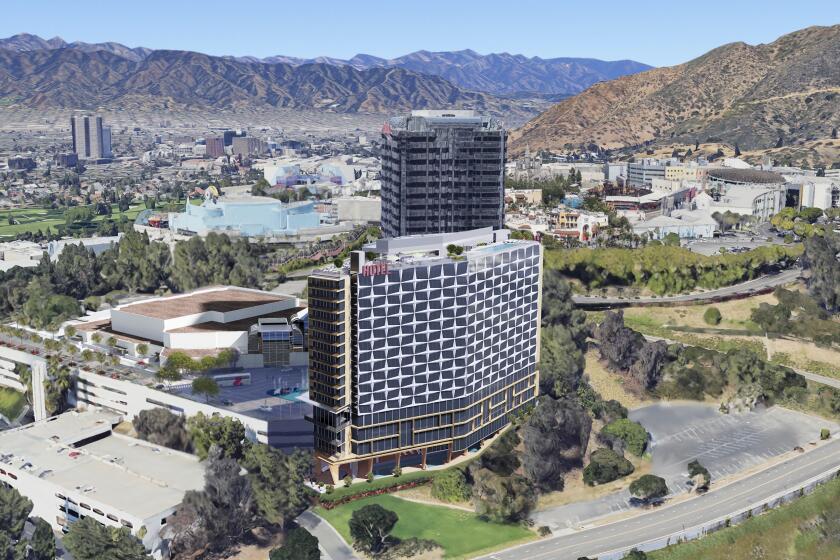
- Share via
- California’s struggle around homelessness has been a black eye and a contentious soft spot for years, and even the most sympathetic of Californians are tired of the squalor and pain.
- Clearing encampments may be a political solution to an ugly problem, but without a place to move people, it’s just optics.
Homeless encampments are dirty. And ugly. And seem, to those who venture near them and even to some who live there, unsafe.
They are also — sadly, wrongly — places of last resort for those whose second, third and even fourth chances haven’t panned out, sometimes through their own mistakes, sometimes because they’re so far down just staying alive is a battle. Though we tend to toss homelessness in the soup pot along with mental illness and drug use, the terrifying fact is that nearly half of the folks living on our streets are over the age of 50 and wound up there because a bit of bad luck left them unable to pay the rent.
“At the end of the day, we have a homelessness crisis because we don’t have enough housing,” Margot Kushel said. She’s a professor of medicine at UC San Francisco and director of the UCSF Benioff Homelessness and Housing Initiative. There’s really no one in the state who understands encampments and their residents better.
Which is why I am deeply disheartened by Gov. Gavin Newsom’s push Monday to encourage cities and counties to outlaw encampments — even providing a handy-dandy boilerplate ordinance for local governments to pass. It moves California one step closer to criminalizing homelessness, no matter how softly or deftly he packages that truth.
Or how politically expedient it may be.
“It is time to take back the streets. It’s time to take back the sidewalks. It’s time to take these encampments and provide alternatives,” Newsom said. “It simply cannot continue. It cannot be a way of life living out on the streets, in sidewalks, in what almost become permanent structures, impeding foot traffic, impeding our ability for our kids to walk the streets and strollers, or seniors with disabilities and wheelchairs, even navigating their sidewalks. We cannot allow that to continue.”
From a political perspective, that tirade is spot on. The clock is already ticking on the 2026 midterms, which coincide with the end of his tenure as California’s leader. Not only is Newsom eyeing the horizon for his next move, presidential or not, but Democrats are eyeing the condition of California and whether Trump and his supporters will be able to once again use it as the example of everything that’s wrong with America, as they did in both 2020 and 2024.
Gov. Gavin Newsom on Monday urged California cities and counties to ban homeless encampments, increasing his pressure campaign on local governments.
Even Kushel, who near daily hears the heartbreaking reasons people are homeless, knows encampments aren’t the answer.
“I do think the encampments are a disaster,” she said. “I want them gone too.”
But, not at the cost of making things worse, which is what breaking them down without a place to put people does. Newsom’s draft ordinance makes nice talk about not criminalizing folks, but also doesn’t require more than “every reasonable effort” to provide shelter to those being displaced — knowing full well that we don’t have enough shelter beds.
It also talks nice about not throwing out people’s belongings, unless maybe they have bugs or feces on them — which, let’s be real, they might — in which case, the dumpster it is, even if that bundle may contain your identification or medications.
That constant loss, constant movement, not only sets people back even more, it also breaks trust and pushes people further out of sight and out of society. So by the time there are shelter beds or treatment centers, you’ve lost cooperation from the people you want to help. Homelessness becomes even more dystopian, if more invisible.
“I actually worry that making people move every day, threatening them with arrest, all of those things make the problem worse and not better,” Kushel said.
Some might recall that this new age of compassionate crackdowns began last year after the Supreme Court ruled in Grants Pass vs. Johnson that it wasn’t cruel or unusual punishment to outlaw camping in public spaces — allowing municipalities to cite or arrest those who did. Newsom’s office took the side of the city of Grants Pass, Ore., filing a brief in support of more enforcement powers. Since then, Newsom — sometimes personally with camera crews in tow — has cleared more than 16,000 encampments on state lands.
Some cities have followed suit with tough laws of their own, including San José. But other cities have resisted, much to Newsom’s dismay.
In Grants Pass, things didn’t go exactly as planned. There’s currently an injunction against its enforcement on camping laws after Disability Rights Oregon sued the city. Tom Stenson, the group’s deputy legal director, told me that the organization has seen how the anti-camping laws have been hard on folks with physical or mental impairments, many of whom are older.
As the housing crunch hit that state, the low-rent places where his plaintiffs lived “disappeared, and then there is just nowhere for them to go, and it just forces them right into homelessness,” he said.
California’s struggle around homelessness has been a black eye and a contentious soft spot for years, and even the most sympathetic of Californians are tired of the squalor and pain. A recent poll by Politico and the Citrin Center for Public Opinion Research at UC Berkeley found that about 37% of voters support arresting folks if they refuse to accept shelter, and that number jumped for male voters and Republicans.
Homelessness is, without a doubt, “the issue that defines more anger and frustration of Californians than any other,” as Newsom put it.
On the same day Newsom put out his legal template for clearing encampments, he also announced $3.3 billion in funding for 124 mental health facilities around the state. It’s money from last year’s Proposition 1, passed by voters, that will add 5,000 residential treatment beds and more than 21,000 outpatient slots to our struggling system of mental health and substance abuse treatment.
The grants include $65 million for Los Angeles to refurbish the Metropolitan State Hospital campus in Norwalk into a psychiatric subacute facility for transitional-age youths, a big and glaring need for the region.
To steal from the history lesson Newsom gave, in 1959 this state had 37,000 mental health beds in locked facilities, the kind that inspired “One Flew Over the Cuckoo’s Nest.” Not ideal.
So the state did away with them, through a series of necessary reforms. But it never built the community-based system that was promised. California is now down to 5,500 locked beds and a bunch of overcrowded, understaffed, outdated jails and prisons that have become our de facto mental health treatment centers, along with the streets. Not ideal.
This investment in a robust community care system that provides both substance abuse and mental health treatment in one place is a huge win for all Californians, and will be a game changer — in about 10 years. Newsom optimistically showed pretty renderings of facilities that will be built with the funds, one even expected to open next year. But folks, building takes time.
Still, Newsom should receive all credit due for taking on a problem ignored for decades and doing something meaningful around it. I’ve seen him act thoughtfully, carefully and forcefully on the issue of homelessness.
Which makes this encampment right-wing swing all the more obviously political, and unworthy of our policy.
Despite those encampments, homelessness in California is actually getting better, though you have to wade through the numbers to see it. There were 187,000 people living without homes in the state last year, according to federal data, a record. About 70% of those people were living unsheltered, more than 45,000 in the city of Los Angeles.
Although the sheer number of people living without homes is overwhelming, it represented an increase of about 3% — compared with an increase of about 18% nationally. Across the country, but not in California, families were the group with the largest single-year increase.
So what we are doing, with policies that prioritize housing and meeting people where they are, is working. What Newsom has done to build a community care system is overdue and revolutionary.
But the fact remains that California does not have enough housing. Clearing encampments may be a political solution to an ugly problem.
But without a place to move people, it’s just optics.
More to Read
Insights
L.A. Times Insights delivers AI-generated analysis on Voices content to offer all points of view. Insights does not appear on any news articles.
Viewpoint
Perspectives
The following AI-generated content is powered by Perplexity. The Los Angeles Times editorial staff does not create or edit the content.
Ideas expressed in the piece
- The article argues that homelessness stems primarily from a lack of affordable housing, with nearly half of unhoused individuals over 50 and pushed into encampments due to financial hardship[1][3]. Criminalizing encampments without adequate shelter or housing alternatives exacerbates instability, erodes trust, and makes long-term recovery harder by displacing people and destroying belongings critical for survival, such as IDs or medications[3].
- Experts like UCSF’s Margot Kushel warn that clearing encampments without providing shelter worsens homelessness by forcing vulnerable populations into invisibility, complicating outreach efforts, and deepening societal disconnection[1].
- While acknowledging public frustration with encampments, the author critiques Gov. Newsom’s recent push for local ordinances to criminalize homelessness as politically motivated, noting that California’s housing-first policies have slowed homelessness growth compared to national trends[1][3].
Different views on the topic
- Proponents of encampment clearances argue they address immediate public safety concerns, such as blocked sidewalks and health hazards, while aligning with voter sentiment: 37% of Californians support arrests if shelter is refused, particularly among male and Republican voters[1][3].
- Newsom’s administration frames the crackdown as a necessary step to “take back the streets,” leveraging Supreme Court rulings like Grants Pass v. Johnson to justify enforcement. This approach aligns with broader conservative critiques of California’s homelessness crisis as a failure of Democratic governance[2][3].
- Critics of housing-first policies argue that encampments enable drug use and mental health crises, advocating instead for mandatory treatment and institutionalization. Newsom’s $3.3 billion investment in mental health facilities reflects this push, though the author notes such solutions will take years to materialize[1][3].
Sign up for Essential California
The most important California stories and recommendations in your inbox every morning.
You may occasionally receive promotional content from the Los Angeles Times.













